
Tripura is a state in Northeast India. The third-smallest state in the country, it covers 10,491 km2 (4,051 sq mi); and the seventh-least populous state with a population of 36.71 lakh. It is bordered by Assam and Mizoram to the east and by Bangladesh to the north, south and west. Tripura is divided into 8 districts and 23 sub-divisions, where Agartala is the capital and the largest city in the state. Tripura has 19 different tribal communities with a majority Bengali population. Bengali, English and Kokborok are the state's official languages.
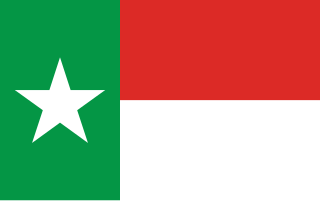
The National Liberation Front of Tripura is a banned Tripuri nationalist terrorist organisation based in Tripura, India. It has an estimated 550 to 850 members.
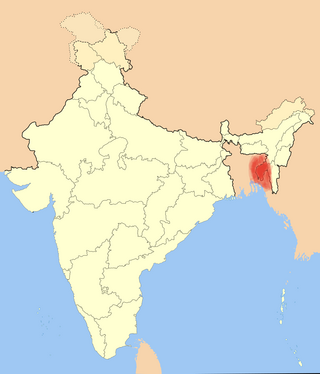
Kokborok is a Sino-Tibetan language of the Indian state of Tripura and neighbouring areas of Bangladesh. Its name comes from kok meaning "verbal" and borok meaning "people" or "human" and is one of the ancient languages of Northeast India.

The State of Tripura has a long history. The Twipra Kingdom at its peak included the whole eastern region of Bongal from the Brahmaputra River in the north and west, the Bay of Bengal in the south and Burma to the east during the 14th and 15th centuries AD.
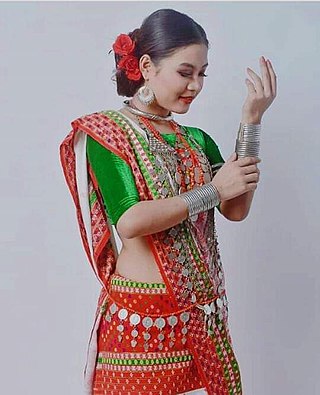
The Tripuri, are a Tibeto-Burman-speaking ethnic group of Northeast Indian state of Tripura. They are the descendants of the inhabitants of the Twipra/Tripura Kingdom in North-East India and Bangladesh. The Tripuri people through the Manikya dynasty ruled the Kingdom of Tripura for many years until the kingdom joined the Indian Union on 15 October 1949.
There are many different dances of the Tripuri people, the largest ethnic group in the state of Tripura.
Kokborok grammar is the grammar of the Kokborok language, also known as Tripuri or Tipra which is spoken by the Tripuri people, the native inhabitants of the state of Tripura. It is the official language of Tripura, a state located in Northeast India.
Reang is a Tripuri clan of the Indian state of Mizoram and Tripura. The Reangs can be found all over the Tripura state in India. However, they may also be found in Assam and Mizoram. They speak the Kokborok language which is known as Kaubru in Reang dailect.
Noatia are one of the Tripuri clan of Tripura state of India. The clan mainly lives in the North Tripura districts of the Tripura state of India. They speak the Noatia dialect of Kokborok which is of Tibeto-Burmese origin.
Uchoi is one of Tripuri clan lives in Tripura state of India and Bangladesh. They are mainly dwelling in the Gomati and the South Tripura districts of Tripura state of India.In Bangladesh, they live in Bandarban Hill District along with other tribes. They speak the language Kokborok which is of Tibeto-Burmese and their dialect is similar with Reang tribe. According to the folk tales, Uchois and Reangs are of same origin.
The Tripura Merger Agreement was the official agreement under which the erstwhile Kingdom of Tripuri joined the state of India.

Rignai is a wrap-around worn by Tripuri women.
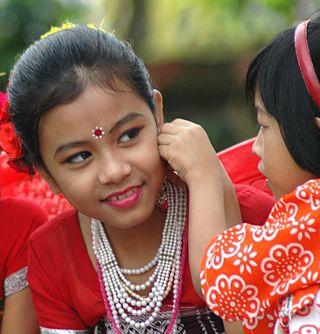
The Tripuri culture of North-East India has many distinctive features.
The Twipra Kingdom was one of the largest historical kingdoms of the Tripuri people in Northeast India.
The Tripuri calendar is the traditional solar calendar used by the Tripuri people, especially in the context of Tripuri irredentism. Its era, the "Twipra Era", "Tripura Era" or Tripurabda is set at 15 April AD 590.

The All Tripura Tiger Force (ATTF) was a Tripuri nationalist militant group active in India's Tripura State. It was founded on 11 July 1990, by a group of former Tripura National Volunteer members under the leadership of Ranjit Debbarma. The ATTF is considered a terrorist organisation by India. According to the South Asian Terrorism Portal, approximately 90% of the ATTF's administration are Hindu and the rest are Christians. The group was said to have been formed as the armed wing of the National Liberation Front of Tripura (NLFT) but split into its own organization. The group was headquartered in Tarabon in Bangladesh.
Tripuri Nationalism is an ideology that supports self-determination by the Tripuri people. The conflict is in essence ethnic and the Tripuri community, indigenous to the region formed the clear majority of population in the princely state of Tippera, which joined the Republic of India in 1949 as the state of Tripura.

The culture of Tripura is distinct and a bit similar to other people of Northeast India. However like Assam, Manipur, Burma and Southeast Asia culture of Tripura is characterized in small portion where people live in plain and hill areas. Tripura is a state in North East India. In the 2001 census of India, Bengalis represented almost 70% of the population and the Tripuri population comprised 30% of Tripura's population. The Tripuri population comprises some clans and ethnic groups with diverse languages and cultures. The largest native group was the Tripuri who had a population of 543,848 in 2001 census, representing 16.99% of the state population and 54.7% of the scheduled tribe population. The other group of people in order of decreasing population were Chakma (6.5%), Halam (4.8%), Mog (3.1%), Munda, Kuki tribes and Garo Hajong. Bengali is the most spoken language, due to the dominance of Bengali people in the state. Kokborok (Tripuri/Tiprakok) is a common language among Tripuris and lingua franca in Tripura. Several other languages belonging to Indo-European and Sino-Tibetan families are spoken by the different tribe
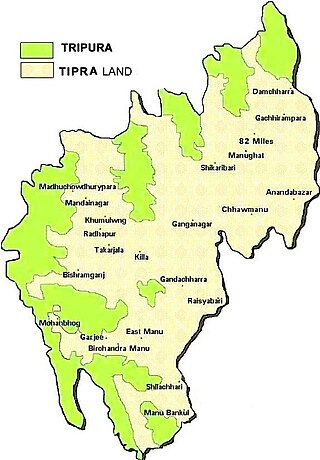
Tipraland is the name of a proposed state in India for the indigenous Tripuri people in the tribal areas of the Tripura state. They demand the Tripura Tribal Areas Autonomous District Council and some surrounding areas to be made into a separate state from Tripura. The proposed state covers 68% of the total geographical area of the Tripura and is home to over one-third of the total population of Tripura.
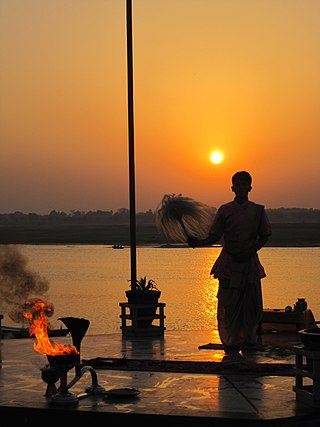
Ganga puja is a religious festival of the northeastern state of Tripura in India. The tribal Tripuri people worship the Goddess of the river, and pray to be saved from epidemic diseases and for the well-being of pregnant women. The celebration involves building a temple of bamboo in the middle of the river or a water stream. The River Ganges, known locally as Ganga, is one of the fourteen prime deities worshipped in this region. The festival is popularly celebrated throughout the state somGanga puja is a religious festival of the northeastern state of Tripura in India. The tribal Tripuri people worship the Goddess of the river, and pray to be saved from epidemic diseases and for the well-being of pregnant women. The celebration involves building a temple of bamboo in the middle of the river or a water stream. The River Ganges, known locally as Ganga, is one of the fourteen prime deities worshipped in this region. The festival is popularly celebrated throughout the state somewhere in March, April or May, with its date fixed according to the Hindu Lunisolar calendar.









